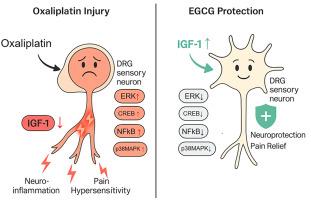Epigallocatechin gallate ameliorates oxaliplatin-induced peripheral neuropathy via upregulation of IGF-1 signaling and suppression of neuroinflammation
IF 4.6
2区 医学
Q1 NEUROSCIENCES
引用次数: 0
Abstract
Chemotherapy-Induced Peripheral Neuropathy (CIPN) is a severe neurological complication characterized by persistent pain and sensory dysfunction. This study investigated the role of Insulin-like Growth Factor-1 (IGF-1) signaling in the pathogenesis of oxaliplatin-induced CIPN and evaluated the therapeutic potential of Epigallocatechin gallate (EGCG). Using an oxaliplatin-induced CIPN mouse model, we examined IGF-1 expression in dorsal root ganglia (DRG) and spinal cord, and assessed the therapeutic effects of intraperitoneal EGCG (50 mg/kg/day) administration. Oxaliplatin induced mechanical hypersensitivity and significantly reduced IGF-1 protein levels, predominantly localized in neurons, within both DRG and spinal cord, while IGF-1 receptor (IGF1R) expression remained unchanged. Daily EGCG administration significantly attenuated oxaliplatin-induced mechanical hypersensitivity and restored neuronal IGF-1 expression in these tissues. These therapeutic effects were accompanied by robust anti-neuroinflammatory actions. EGCG treatment significantly reduced oxaliplatin-induced microglia/macrophage activation (Iba-1 positive cells) in both DRG and spinal dorsal horn (SDH). Furthermore, EGCG suppressed the phosphorylation of NFκB, p38 MAPK (notably in Iba-1 positive cells), and ERK, key inflammatory signaling molecules. EGCG also reversed the oxaliplatin-induced increase in phosphorylated CREB and diminished expression of the pain marker Calcitonin Gene-Related Peptide (CGRP). Interestingly, the phosphorylation of AKT, a common downstream effector of IGF-1, was not significantly altered by EGCG treatment in this model. In conclusion, our study demonstrates EGCG's therapeutic potential in CIPN by enhancing neuronal IGF-1 signaling and suppressing neuroinflammation through the modulation of NFκB, p38 MAPK, ERK, and CREB pathways. These findings highlight EGCG as a promising candidate for CIPN management, warranting further investigation.

没食子儿茶素没食子酸酯通过上调IGF-1信号和抑制神经炎症改善奥沙利铂诱导的周围神经病变。
化疗引起的周围神经病变(CIPN)是一种以持续疼痛和感觉功能障碍为特征的严重神经系统并发症。本研究探讨了胰岛素样生长因子-1 (IGF-1)信号在奥沙利铂诱导的CIPN发病机制中的作用,并评估了没食子儿茶素没食子酸酯(EGCG)的治疗潜力。使用奥沙利铂诱导的CIPN小鼠模型,我们检测了IGF-1在背根神经节(DRG)和脊髓中的表达,并评估了腹腔注射EGCG (50 mg/kg/天)的治疗效果。奥沙利铂诱导机械超敏反应,显著降低IGF-1蛋白水平,主要定位于神经元,在DRG和脊髓内,而IGF-1受体(IGF1R)表达保持不变。每日给药EGCG可显著减弱奥沙利铂诱导的机械超敏反应,恢复这些组织中神经元IGF-1的表达。这些治疗效果伴随着强大的抗神经炎症作用。EGCG治疗显著降低奥沙利铂诱导的DRG和脊髓背角(SDH)小胶质细胞/巨噬细胞活化(Iba-1阳性细胞)。此外,EGCG抑制nf - κ b、p38 MAPK(特别是在Iba-1阳性细胞中)和ERK等关键炎症信号分子的磷酸化。EGCG还逆转了奥沙利铂诱导的磷酸化CREB的增加和疼痛标志物降钙素基因相关肽(CGRP)的表达减少。有趣的是,在该模型中,IGF-1的常见下游效应物AKT的磷酸化并没有被EGCG处理显著改变。总之,我们的研究表明EGCG通过调节NFκB、p38 MAPK、ERK和CREB通路,增强神经元IGF-1信号,抑制神经炎症,从而在CIPN中具有治疗潜力。这些发现强调了EGCG作为CIPN管理的有希望的候选者,值得进一步研究。
本文章由计算机程序翻译,如有差异,请以英文原文为准。
求助全文
约1分钟内获得全文
求助全文
来源期刊

Neuropharmacology
医学-神经科学
CiteScore
10.00
自引率
4.30%
发文量
288
审稿时长
45 days
期刊介绍:
Neuropharmacology publishes high quality, original research and review articles within the discipline of neuroscience, especially articles with a neuropharmacological component. However, papers within any area of neuroscience will be considered. The journal does not usually accept clinical research, although preclinical neuropharmacological studies in humans may be considered. The journal only considers submissions in which the chemical structures and compositions of experimental agents are readily available in the literature or disclosed by the authors in the submitted manuscript. Only in exceptional circumstances will natural products be considered, and then only if the preparation is well defined by scientific means. Neuropharmacology publishes articles of any length (original research and reviews).
 求助内容:
求助内容: 应助结果提醒方式:
应助结果提醒方式:


